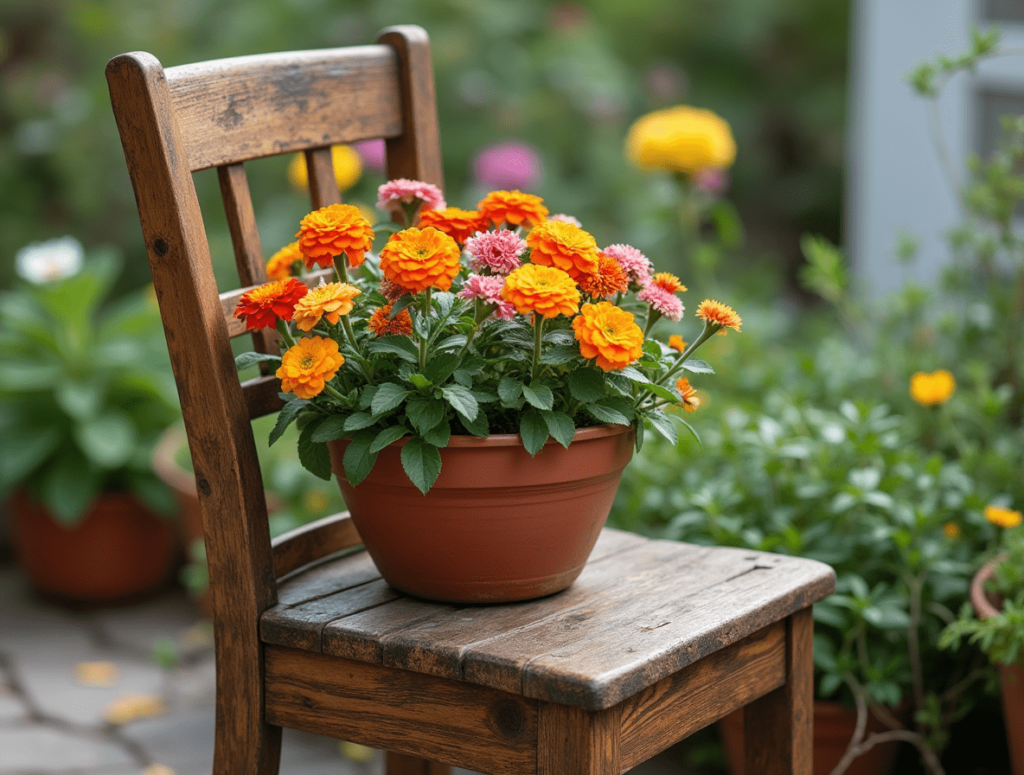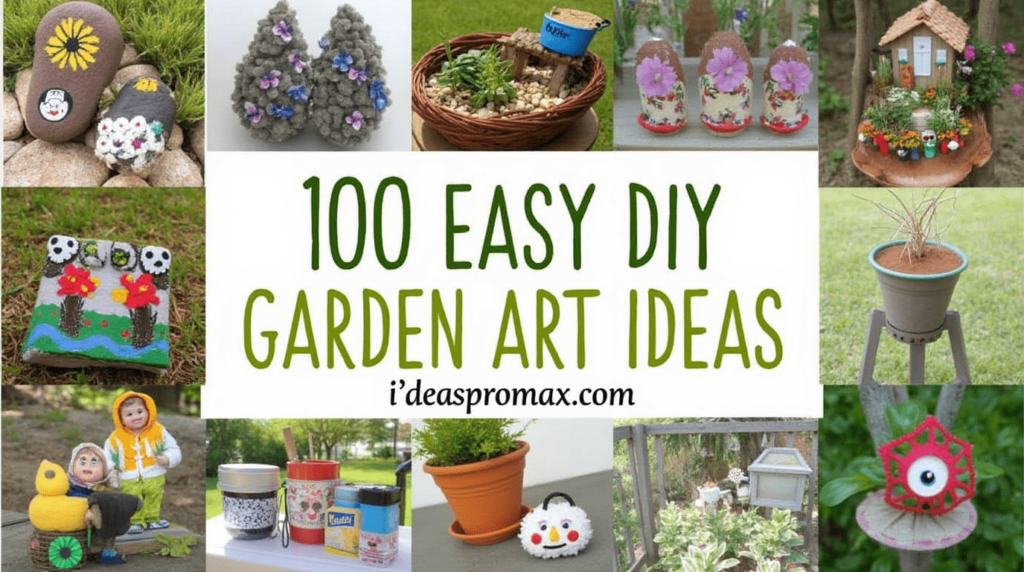Transform forgotten furniture into a standout garden feature with chair planters—a creative upcycling project that combines vintage charm with vibrant blooms. By removing the seat from an old wooden chair and replacing it with colorful flowers, you can create a whimsical garden accent that adds character and conversation value to any outdoor space. This comprehensive guide walks you through the process of crafting these unique planters that blend nostalgia with nature.
Why Chair Planters Make Perfect Garden Statements
Old wooden chairs possess inherent charm that makes them ideal candidates for repurposing. Their familiar silhouette creates an instant visual connection, while their sturdy frame provides the perfect structure for displaying plants. Chair planters work particularly well as focal points near entrances, in garden corners, or alongside pathways where their distinctive shape can be fully appreciated.
Interior designer and garden enthusiast Maria Sanchez notes, “Chair planters create that perfect juxtaposition between the manufactured and natural world. They tell a story of transformation—taking something designed for one purpose and giving it new life in an unexpected way.”
Materials You’ll Need
Before beginning your chair planter transformation, gather these essential supplies:
- An old wooden chair (with or without a damaged seat)
- Screwdriver or pry bar for removing the existing seat
- Sandpaper (medium and fine grit)
- Exterior paint or wood stain
- Paintbrushes and small roller
- Weatherproof sealer
- Wire cutters and wire mesh (optional)
- Heavy-duty staple gun (optional)
- Coconut liner, landscape fabric, or similar material
- Potting soil
- Selection of plants
- Decorative elements (optional)
Chair Selection Tip: Look for chairs with interesting architectural features like spindles, curved backs, or detailed carvings. These elements will enhance the visual appeal of your finished planter.
Step-by-Step Chair Planter Creation
1. Select and Prepare Your Chair
Choose a chair with good structural integrity, particularly in the legs and back. Remove any cushions or fabric. If the chair needs cleaning, wipe it down with a damp cloth and mild detergent. Allow it to dry completely before proceeding.
2. Remove the Existing Seat
Using a screwdriver or pry bar, carefully remove the seat portion of the chair:
- For chairs with a removable seat, simply unscrew it from beneath
- For chairs with integrated seats, you may need to cut out the center portion, leaving a frame
Sand any rough edges to prevent splinters and create a smooth surface for your plants.
3. Refinish for Weather Resistance
This crucial step extends the lifespan of your chair planter:
| Finish Type | Best For | Durability |
|---|---|---|
| Exterior Paint | Bold colors, pattern creation | 3-5 years with proper sealing |
| Wood Stain | Highlighting natural wood grain | 2-4 years with proper sealing |
| Clear Sealer Only | Preserving original patina | 1-3 years, requires reapplication |
Apply 2-3 coats of your chosen finish, allowing proper drying time between applications. Finish with a weatherproof sealer for maximum protection against the elements.
4. Create the Planting Area
You have several options for creating the planting space:
Option A: Direct Planting Frame
- Attach wire mesh across the seat opening using staples or small nails
- Line with coconut liner or landscape fabric
- Fill with soil directly
Option B: Removable Container
- Select a container that fits the seat opening
- Consider using a plastic pot with a lip that prevents it from falling through
- This option allows for easier seasonal changes
Option C: Hanging Basket Conversion
- Install hooks under the seat frame
- Hang a pre-made basket from these hooks
- Especially good for trailing plants
5. Select and Arrange Plants
Consider these factors when choosing plants:
- Sun exposure where the chair will be placed
- Color scheme that complements the chair finish
- Plant height to ensure visual balance
- Seasonal interest for year-round appeal
Popular plant combinations include:
- Colorful annuals like petunias, million bells, and verbena for sunny spots
- Ferns, impatiens, and coleus for shaded locations
- Succulents and sedums for low-maintenance options
- Herbs like thyme, rosemary, and lavender for functional beauty
6. Position and Maintain Your Chair Planter
Place your finished chair planter in a location where it can serve as a focal point. Consider these placement ideas:
- Beside a garden path
- On a porch or patio
- As the centerpiece of a small garden vignette
- Nestled among larger plants as a surprise element
Water regularly, accounting for the potentially faster drainage of chair planters compared to traditional containers.
Creative Variations to Try
- Chair Planter Family: Group several chairs of different sizes painted in coordinating colors
- Climbing Plant Showcase: Position climbing plants to grow up and through the chair back
- Cascading Effect: Plant trailing varieties that spill over the edges and down the legs
- Fairy Garden Chair: Create a miniature landscape incorporating tiny accessories
- Seasonal Theme Chair: Change plantings and decorative elements to match holidays or seasons
Bringing Indoor Elements Outdoors
Chair planters perfectly illustrate the growing trend of blurring the lines between indoor and outdoor decorating. This technique creates intriguing visual contrast that captures attention and imagination. Other complementary ideas include:
- Repurposed dresser drawers as raised beds
- Old wooden ladders as plant stands
- Vintage suitcases as container gardens
- Teacups and teapots as small planters
Preservation Tips for Longevity
To extend the life of your chair planter:
- Place small feet under chair legs to prevent direct ground contact and moisture absorption
- Apply fresh sealer annually before the rainy season
- Consider moving the planter to a protected area during extreme weather
- Check regularly for signs of water damage or insect activity
- Drain excess water after heavy rains to prevent wood rot
The Story-Telling Value of Chair Planters
Perhaps the most compelling aspect of chair planters is their narrative quality. Each carries the history of its former life while embracing its new purpose. This transformation creates an instant conversation piece that connects with visitors on an emotional level.
Garden designer James Peterson explains, “Objects that have been repurposed carry a certain soul with them. A chair planter isn’t just displaying flowers—it’s telling a story about sustainability, creativity, and seeing new potential in forgotten things.”
Conclusion: Sit Back and Watch Your Garden Grow
Chair planters represent the perfect blend of nostalgia, creativity, and practical gardening. By removing the seat from an old wooden chair and replacing it with a vibrant display of flowers, you create a unique garden accent that adds personality and charm to any outdoor space.
Whether you choose a simple, rustic approach or an elaborate, artistically painted creation, these distinctive planters inject character into your landscape while giving new purpose to pieces that might otherwise be discarded. The combination of familiar form and unexpected function makes chair planters particularly appealing focal points that draw the eye and spark imagination.
Ready to transform that forgotten chair into a garden masterpiece? Gather your materials, unleash your creativity, and watch as your outdoor space comes alive with the distinctive charm of chair planters.
What furniture pieces have you repurposed for your garden? Share your chair planter creations or ideas in the comments below!


